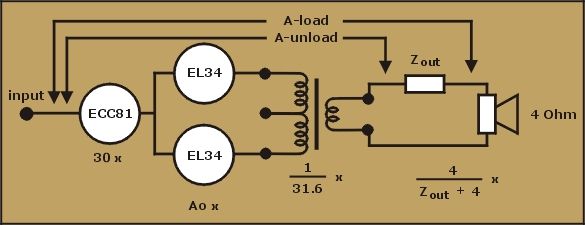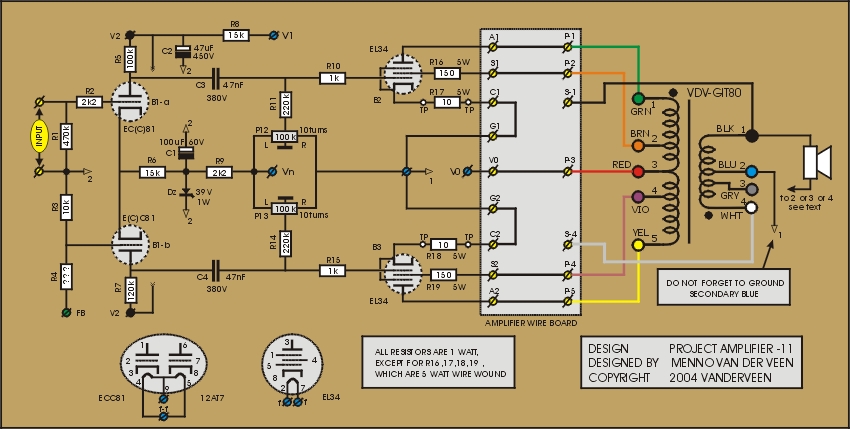Inside amplifier 11 we apply local feedback at the screen grids. They are connected to taps at the primary and receive 1/3 of the alternating voltage at each corresponding anode. This local feedback lowers the amplification factor of the power tubes. Details of the circuit are shown below, while the standard form (click ![]() here) contains all the measurement results.
here) contains all the measurement results.
This local feedback totally changes the subjective character of the amplifier. The sound is cleaner than with amplifier 10 and less warm, details are much more clear. The power and frequency range are comparable to amplifier 10. The damping factor is higher; the loudspeaker is better under control and there is less reaction to its impedance curve. This explains why amplifier 11 has more control, delivering a tighter bass.
The measurement results show more interesting details. The lowest full power frequency stays on 14 Hz, which is fully understandable because the core of the OPT has not changed. Also the lowest –3dB frequency stays the same. This frequency is mainly determined by C3 and C4 and I did not change these components. The effective amplification A-loaded has changed from 13.3 in amplifier 10 to 9.5 in amplifier 11, while A-unloaded changes from 190 to 31.6. These changes in amplification factors and their effects will be discussed in detail.
Inside the universal amplifier, each section of the ECC81 amplifies approximately 15 times, therefore the total amplification equals 2 x 15 = 30 times. The output transformer ‘amplifies’ the alternating voltage at the anodes by a factor Ns / 1.4 / Np = 1 / 31.6. These numbers show that the amplification of the ECC81 and the OPT together equals almost 1. What is left over is the amplification factor of the EL34 power tubes. See the figure below.

In amplifier 10 each power tube therefore amplifies 190 times, while in amplifier 11 the tubes amplify 31.6 due to the local feedback. This means that the local feedback at the screen grids has lowered the amplification inside the power tubes by a factor of 190 / 31.6 = 6. That being the case, then the plate resistance of the power tubes should also lower by a factor of 6. This is easy to control, because Z-out is directly related to these plate resistances. Z-out has changed form 53 Ohm in amplifier 10 to 9.3 Ohm in amplifier 11, which is rounded the same factor of 6. Conclusive: the local feedback lowers the gain of the amplifier and lowers the output impedance with the same factor (as the feedback theory says). What is the first result? A 6 times higher speaker damping. And what is a result as well? A 6 times lower harmonic distortion, which explains why we much better can hear the details in the sound.
Next time: amplifier 12

